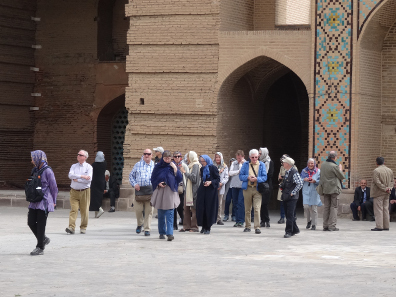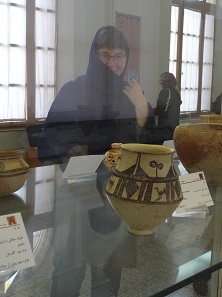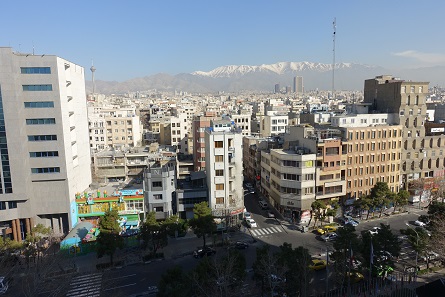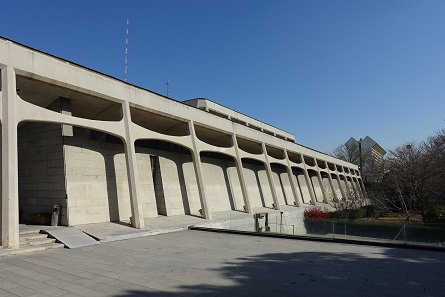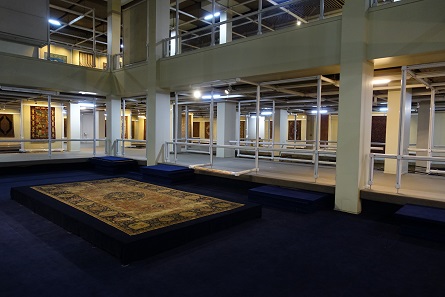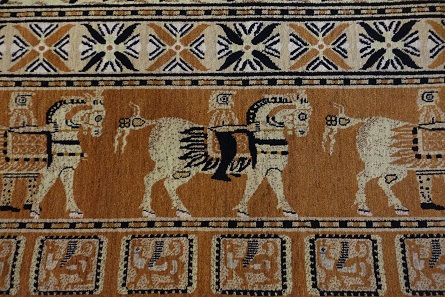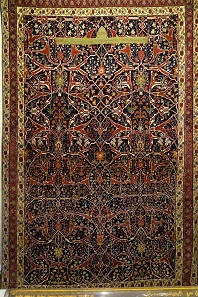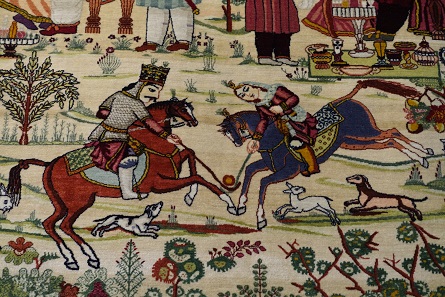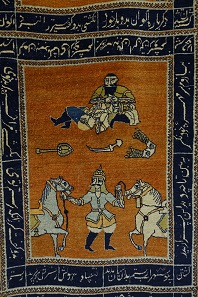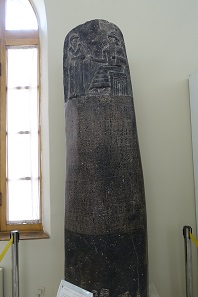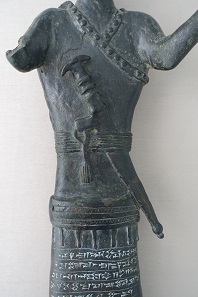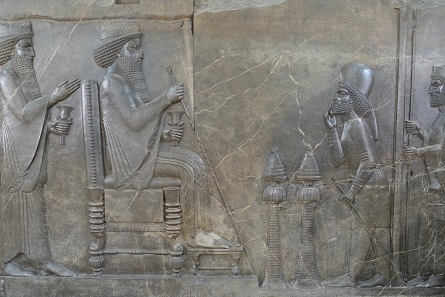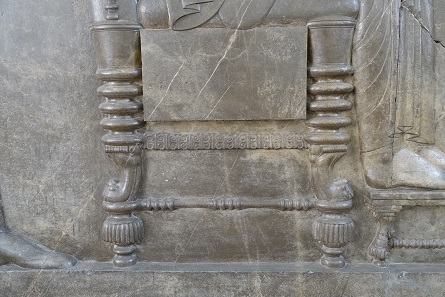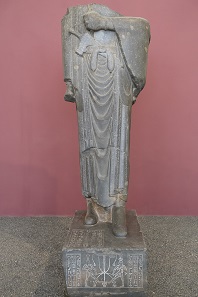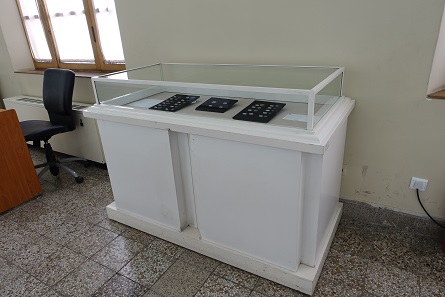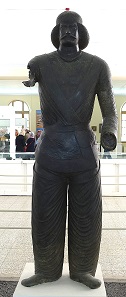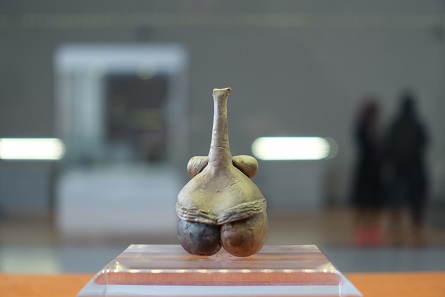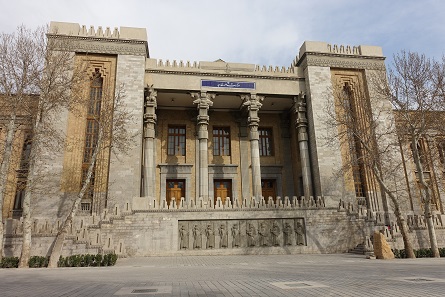by Ursula Kampmann
translated by Teresa Teklic
March 31, 2016 – Up front I should say one thing to prevent misunderstandings which several letters to the editor have already foreshadowed: This travel diary is not meant as a political statement. I am aware that between 1 January and 15 July 2015 alone, 694 people were executed in Iran. And of course I do not think that this is ok.
I am, however, also aware that my opinion does not always coincide with that of the German government and I would hate to be regarded as “the German” instead of “Ursula Kampmann”. A country and its population are more than its government. It is the sum of many individuals, some of which have more, and others less, to say. That is why, I repeat, this diary is not a political statement but no more than an account of what I experienced during the 17 days I spent in Iran.
Our Group in Qazwin. Photo: KW.
I was travelling with a party and mainly visited touristic highlights. Understandably, there were only very limited possibilities to integrate my numismatic preferences into the program. The trip was organised by the Reisehochschule Zürich (a travel agency for study trips). We were always accompanied by the German-Suisse archaeologist and Islamic studies scholar Dr Sigrid Hodel-Hoenes, who, with her year-long experience with Iranian culture and traditions, became our guiding compass. By our side were an Iranian tour guide called Ehsan, a bus driver, Nadir, and his assistant, Mustafa – and I was glad about every single one of them. I never (!) want to drive a car in an Iranian city. I’d do anything rather than this, even peak traffic in Palermo. Without Ehsan I wouldn’t have been able to even hire a taxi. And the basic organisation of this trip would have already been beyond my competence. Especially the North and Northwest lack in touristic infrastructure so much that I would have failed to even book a hotel room.
I was lucky to have such a wonderful group of people who made this trip possible. Our fellow travellers made up for the many times I would have preferred to be travelling alone and do my own thing.
But enough of the preliminaries. Here comes part one of my Iran travelogue.
Thursday, 3 March 2016
I am a suspicious subject. At least in the eyes of the US government. I will not be granted an ESTA visa like other EU citizens. For one reason only: I have travelled to Iran. People who travel to Iran seem to be generally suspicious. They need to state specific reasons for travelling Iran. But, I wonder, will the average US embassy staff member understand why I wanted to see Persepolis once in my life? And before it gets destroyed like so many other things in the Middle East?
I really have travelled far in my life but no journey of mine has ever excited so many comments from the people around me. “Are you crazy?” “Take care of yourself and come back in one piece!” or “I would love to do that as well!”
My politically correct outfit: hair and neck veiled, the arms covered up to the wrists. Photo: KW.
And I admit, I was very insecure before the departure myself. I spent hours wondering how to dress adequately in Iran. I learned a lot on this occasion, for instance that there are a number of shops on the internet that sell clothes which are in accordance with the Qur’an. I bought two harem pants and a balaclava (only shows part of the face, worn by pious Turkish women under their headscarf), as well as a huge headscarf, and I dug around in my wardrobe to see how many tops I had which cover my thighs. My coat is already dark, more than long enough and thus “halal,” which means “permissible,” as you can read on Wikipedia.
Of course everything was different once we were actually there, but that’s another story.
Anyway. So we took off. Our flight departed at 6.15 pm from Zurich. A few people at the gate looked conspicuous. Dangling from their hand luggage were the rhz tags. Those must be our fellow travellers. How strange to imagine that we would be spending the next 17 days together!
We flew to Istanbul with Turkish Airways and continued from there to Tehran. What I did not expect was that we only landed on
Friday, 4 March 2016
around 6 am. At the point where package holiday tourists normally clap their hands, all female travellers reached for their purses and got out their headscarves. The dress code for women in Iran is regulated by law: arms and legs must be covered up to the ankles and wrists, hair and neck covered completely. I did have my super-mega-large headscarf, but try to put that on within the confined 1 square meter of your seat on the airplane. After several unsuccessful attempts I decided to use a smaller, dark red, scarf instead (even though red was also classified as a “no go”…).
Apparently the Iranians were happy with my attire as all went well. Our visas were checked briefly. After less than 10 minutes we were standing in front of the baggage carousel that soon began to happily rotate our suitcases round and round. The friendly nod that our travel guide directed towards the customs officer qualified as customs formalities for us. No bureaucracy, no paper chaos or forms to fill out, not even an unfriendly look. And we were standing on Iranian soil. Wait, not quite yet. Before we passed the gate a pretty unfriendly officer wanted to see all of the men’s passports again. What a happy coincidence that the women in our party far outnumbered the men. And then we were in Iran.
View of the Alborz mountain range. Tehran is already at an altitude of 1,100 m, Mount Damavand, the highest mountain of the Alborz mountain range, at 5,604 m. Photo: KW.
If you were looking forward to crawling into your comfortable bed after the long journey, you were disappointed. Tehran airport is a good hour’s drive outside of Tehran. Since even in Tehran not much was up at 6 am on a Friday – which, for good Muslims, is the counterpart to our Sunday – we arrived at the hotel a short hour later and went to bed completely exhausted shortly after 7 am, only to be woken up two hours later. After all, we had booked a study-trip and we had a schedule to get through.
Many years ago, when I financed by student life by working as a travel guide, I asked my boss why all travel schedules had to be so packed. He said that people book their trips at home. And when you are comfortably sitting on your couch, you book the trip which offers you the most tourist attractions. Once you’re there it’s a different story altogether. I have to agree with him. I, for my part, didn’t care about the Carpet Museum of Iran one bit after two hours of sleep. Nothing but my sense of duty got me in the shower.
Breakfast? Nope, we had slept too long for that (or not showered fast enough). At least I managed to exchange 100 euros – for a start. In return I received 3.6 million riyal! Impressive. Becoming a millionaire can be so easy!
Carpet Museum of Iran – the architecture resembles warp and woof on a loom. In the background: Our Hotel Laleh (=tulip), whose shape is vaguely reminiscent of a tulip. Photo: KW.
Our hotel with the beautiful name Laleh (=tulip) was right next to Laleh Park, where the Carpet Museum of Iran is located. The museum was still set up by Farah Diba, its theme is the “Persian carpet” known all around the world. Only few people will know that the consultant of the donor was previously the Director of the Museum of Islamic Art in Berlin …
A look into the interior of the carpet museum. Photo: KW.
Today they are seldom found in modern apartments but I still remember clearly that a (more or less original) Persian rug was an essential item of furniture for my parents. Persian carpets were the epitome of luxury and had been for centuries. We know them from Dutch still lifes, and English dandies used them to decorate their oriental rooms.
Detail from the reproduction of the Pazyryk carpet. Photo: KW.
One of the first items that you see in the carpet museum is a reproduction. The carpet which was retrieved from one of the kurgans of Pazyrzk is recognised as the oldest Persian carpet in the world.
Detail from a 19th century carpet. Photo: KW.
So we looked at the many carpets, small ones and big ones, all of them very colourful and – surprise – with lots of …
Horseman and -woman playing polo. Photo: KW.
… human figures. If you’re expecting an imageless Islam in Iran, this museum will prove your expectations wrong. The carpets are filled with the most colourful images, of rulers and clergymen, men and women who play polo …
Something mythological; what exactly I haven’t found out just yet… Perhaps an Arabic-speaking reader could help? Photo: KW.
… mythological motifs, animals, hunting scenes from the Sassanid dynasty. Of course, we also saw artworks with geometrical forms but they were clearly underrepresented.
A carpet monster: In the centre, Louis XIV, to his right Napoleon and Peter the Great. Photo: KW.
The most incredible piece was a gigantic carpet monster – please believe me when I say that I do not want this thing in my flat, not for the life of me – featuring a member of the Pahlevi dynasty and above, on a giant central field, the great (absolutist) rulers in the history of men. There was Louis XIV, next to Napoleon, Peter the Great and even “Old Fritz” (Frederick the Great). It was a picture puzzle in the shape of a carpet and solving it turned out to be great fun. There must have been captions once since there were Arabic numbers above each of the figures …
National Museum of Iran. Photo: KW.
From the Carpet Museum of Iran we made our way to the National Museum of Iran. And at record speed, because although all the pious Iranians go to the mosque on Friday, the large majority prefers to spend the morning in bed. Meaning, the streets were pleasantly empty.
Already the architecture of the National Museum, designed by the French historian and archaeologist André Godard, is fascinating. Instated by Reza Shah, Godard simultaneously served as Director of the Iranian Archaeological Service and Director of the National Museum of Iran between 1928 and 1953, and between 1956 and 1960. To create a setting worthy of the museum, Godard designed a building after what he imagined the Sassanid palace in Firuzabad looked like. A colossal building, but even better was what was inside of it.
Ivory fragments from Teppe Hasanlu. Photo: KW.
Those who like ceramics stopped right at the first show case. Ceramics, unfortunately, are not really my thing. Still, there was so much more to see. We saw finds from several excavations which we were to visit in the course of our trip, for instance from Hasanlu in Western Azerbaijan.
Bull from Chogha Zanbil. Photo: KW.
This bull sculpture, one meter tall and made of terracotta, is from Chogha Zanbil.
The Code of Hammurabi … as a copy. Photo: KW.
Several finds from Susa were also on exhibition, among them the famous stele of Hammurabi from Babylon, although it is not the original. Like most of the more important objects from Susa, it is on exhibition in the Louvre. The French had been excavating there since the second half of the 19th century (the first Director of the Iranian Archaeological Service was a Frenchman for a reason).
Luristan bronze; axe head, late 2nd/ early 1st millennium BC. Photo: KW.
Luristan bronzes are among the most impressive exhibits of early metal work. And the bronzes on display were so diverse! Axes and vessels, standards and figurines, …
The statue even bears an inscription: il-tir-ga-zi, the God of the city, who had been abducted and brought to Bur-nak-ku, marduk-sarrani, son of Sulmanu-asaridu, ruler of the land se-ma-is, returned him back to his former location. Photo: KW.
… among them even the statue of a man wearing a Luristan dagger on his belt.
Courtier showing reverence to Persian ruler. Photo: KW.
And then, all of a sudden, we were standing in front of a relief from Persepolis that I have seen countless times in books. It was breath-taking. The quality of the work was fantastic! Not even the Elgin Marbles would be superior in comparison. The utter stillness of the figures which look so composed when showing the King of Kings their reverence is captivating. And the best thing was: No Japanese, no Iranian was taking selfies in front of it.
Iranians love selfies, you must know. And there were a lot of Iranians in the National Museum. I thought that was remarkable. When I think of other countries and their museums, native visitors are usually rather underrepresented. Not here. Those present – mostly rather young (!) people – read the labels of the objects carefully and studied them at length. And sometimes they would look in our direction, dare a shy smile, a “Hi” or “Hello,” and – those with enough courage – a “Where are you from”. And two or three said what has become the title of this diary because we heard it so many times: “Welcome to Iran!”
Relief detail: the throne. Photo: KW.
But back to the relief. Does the throne remind you of something?
Alexander III, 336-323. Tetradrachm, 317-311, Babylon. From Gorny & Mosch auction sale 164 (2012), 164.
For instance of the throne of Zeus on Alexander’s tetradrachms from Babylon?
Dareius I, bearing hieroglyphic inscriptions because it was made for an Egyptian sanctuary …Photo: KW.
Right next to it is a statue of Dareius I, unfortunately headless. It was made for an Egyptian sanctuary and therefore bears its inscription in hieroglyphs. The inscription on the pedestal lists all peoples that Dareius defeated, among them – easily readable for the expert of late Egyptian – …
In case your hieroglyphic is a bit rusty, the fourth and third cartouches from the right are Cappadocia and Lydia. Photo: KW.
… the Cappadocians and the Lydians.
Coins of, let’s say, not the highest quality. Photo: KW.
There were, by the way, also two show cases with coins, not presented less attractively than the other objects. Admittedly, modern scenography has yet to reach Iran. However, that was generally of rather secondary importance in view of the fantastic exhibits – that is, with the exception of the coins, which were in a less than pristine condition …
Larger-than-life Parthian statue in bronze. Photo: KW.
If you are interested in the Parthians, you will surely recognise this larger-than-life statue of a Parthian ruler from Shami. The immensely impressive sculpture shows in great detail what a Parthian nobleman dressed like. His pants are strongly reminiscent of the pants that are today mainly worn by Kurdish men.
Venus of Sarab, from Tappeh Sarab. Photo: KW.
Those who still hadn’t seen enough after the Persians, Parthians, and Sassanids, could continue to the first floor, where many finds from the pre-history of Iran could be discovered. We strolled across the halls dutifully, were pretty exhausted and surprised by the stamina displayed by our fellow travellers. While we were already enjoying a coke in the comfortable shadow on the stairs in front of the museum, they were still holding out inside, listening to Ms Hodel’s explanations.
Iranian Ministry of Foreign Affairs. Photo: KW.



